Catering Services in Australia Market Overview:
The catering services market in Australia is witnessing consistent growth, fuelled by rising demand from sectors such as corporate, healthcare, education, and event management. This market encompasses a broad range of services, including on-site catering, corporate meal solutions, and event-specific services. Our report offers a comprehensive analysis of procurement trends, highlighting cost-saving strategies and the adoption of digital tools to streamline service delivery and management processes.
Key future challenges in procurement for catering services include managing fluctuating food prices, ensuring vendor reliability, and addressing increasing client demands for sustainability and dietary customization. Utilizing digital procurement tools and strategic vendor partnerships are essential for optimizing the catering supply chain and achieving long-term competitiveness. As demand for catering services grows, companies are leveraging market intelligence to enhance efficiency and mitigate risks.
The catering services market in Australia is projected to maintain steady growth through 2032, with notable highlights including:
- Market Size: The global catering services in australia market is projected to reach USD 101.68 billion by 2032, growing at a CAGR of approximately 10.41% from 2024 to 2032.
Growth Rate: 10.41% 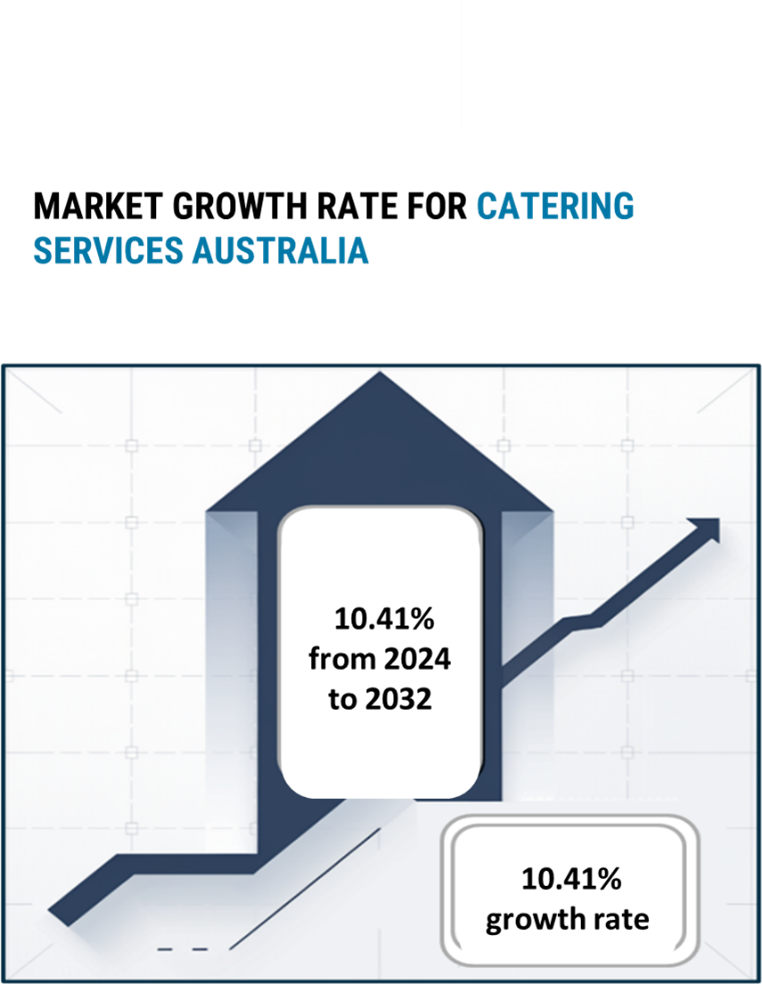
- Sector Contributions: Growth in the market is driven by:
- Corporate Sector: Rising demand for tailored meal plans and event-specific catering solutions for businesses.
- Event and Institutional Services: Expansion of events and healthcare institutions, requiring large-scale and customized catering solutions.
- Technological Transformation and Innovations: Advancements in service technology, such as automated ordering systems, real-time inventory tracking, and data-driven menu customization, are enhancing operational efficiency and customer satisfaction.
- Investment Initiatives: Companies are adopting advanced kitchen technologies and sustainable practices to improve efficiency and meet evolving client expectations.
- Regional Insights: Australia Urban centres like Sydney, Melbourne, and Brisbane remain key markets, driven by corporate demand and frequent large-scale events.
Key Trends and Sustainability Outlook:
- Digital Integration: Automation in catering management, such as online ordering platforms and real-time kitchen monitoring systems, is reducing errors and optimizing workflows.
- Sustainable Practices: Increased focus on reducing food waste, using locally sourced ingredients, and adopting eco-friendly packaging.
- Dietary Customization: Rising demand for meal options catering to specific dietary needs, including vegan, gluten-free, and allergy-friendly menus.
- Big Data in Catering: Leveraging analytics to predict demand, minimize waste, and maintain high service standards.
Growth Drivers:
- Corporate Events: Increased frequency of business meetings and employee engagement programs requiring professional catering services.
- Healthcare and Education: Growth in healthcare facilities and educational institutions demanding nutritious, large-scale catering solutions.
- Regulatory Standards: Stricter food safety and quality regulations are driving the demand for certified, high-quality catering services.
- Sustainability Focus: Businesses investing in sustainable sourcing and environmentally conscious practices to meet market expectations.
- Personalized Services: Rising consumer preference for tailored catering solutions for events, weddings, and special occasions.
Overview of Market Intelligence Services for Catering in Australia:
Market intelligence reports have identified key challenges, including volatile food prices and managing the complexities of sourcing diverse menu options. These reports provide actionable insights to identify cost-saving opportunities, enhance vendor management, and strengthen supply chain resilience. Organizations benefit from these insights by maintaining compliance, upholding quality standards, and managing costs effectively.
Procurement Intelligence for Catering Services Australia: Category Management and Strategic Sourcing
To maintain a competitive edge in the Australian catering market, companies are refining procurement strategies by utilizing spend analysis and optimizing vendor management processes. Effective category management and strategic sourcing are pivotal for minimizing procurement costs and ensuring consistent delivery of high-quality services. By leveraging actionable market intelligence, businesses can streamline their procurement processes and negotiate favourable terms with vendors, ensuring reliable and efficient catering solutions.
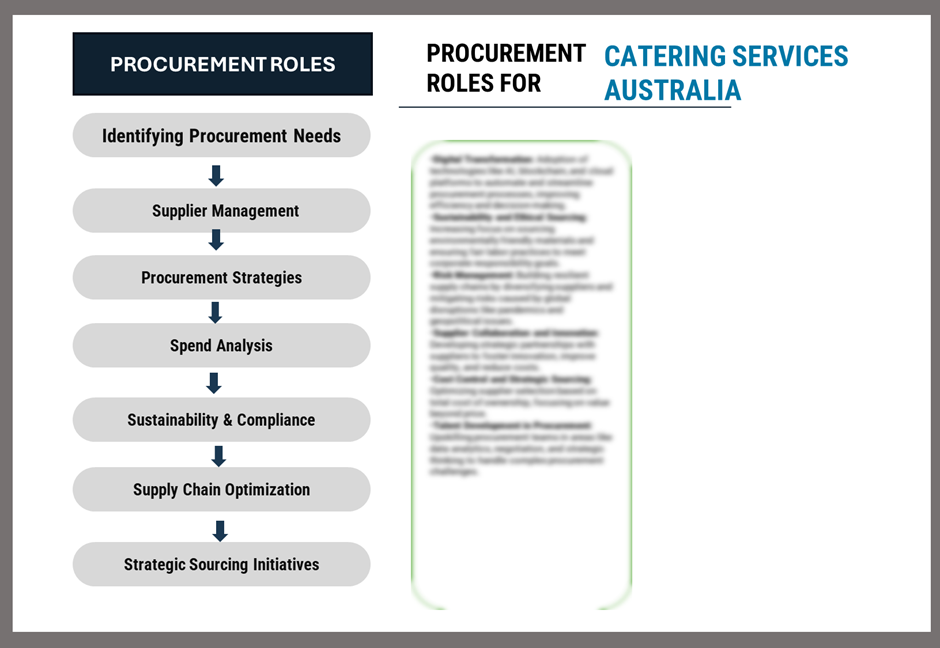
Pricing Outlook for Catering Services Australia: Spend Analysis
The pricing outlook for catering services in Australia is anticipated to remain moderately stable, with potential increases influenced by several key factors. Rising food costs, particularly for fresh produce, meat, and other essential ingredients, play a significant role in cost variations. Additionally, increasing client demand for customized menus, premium services, and dietary-specific options like vegan or gluten-free meals is impacting pricing trends.
Graph shows general upward trend pricing for catering services and decreasing demand. However, there may be fluctuations influenced by economic conditions, technological advancements, and competitive dynamic.
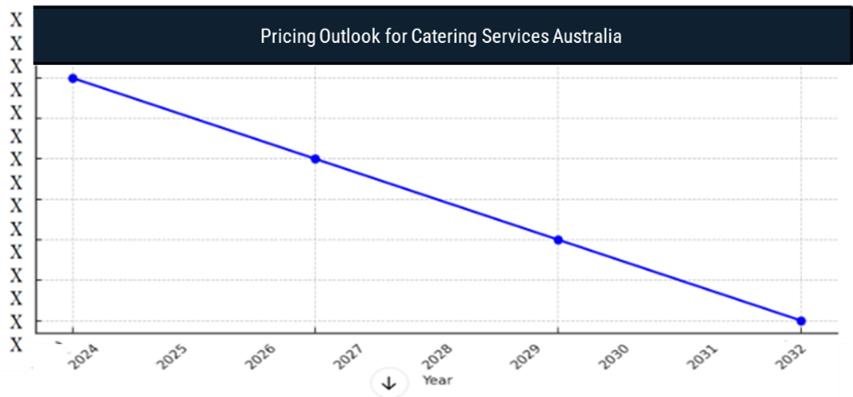
Efforts to improve operational efficiency, minimize food waste, and adopt advanced technologies such as automated inventory systems and digital ordering platforms are critical for cost control. Furthermore, sourcing locally grown ingredients and adopting sustainable practices can help mitigate rising costs.
Collaborating with reliable suppliers, enhancing logistics efficiency, and prioritizing eco-friendly solutions remain crucial strategies for managing expenses. Despite these challenges, a focus on quality assurance, compliance with food safety standards, and innovation in menu design will be essential to ensure competitive pricing.
Cost Breakdown for Catering Services Australia Total Cost of Ownership (TCO) and Cost-Saving Opportunities.
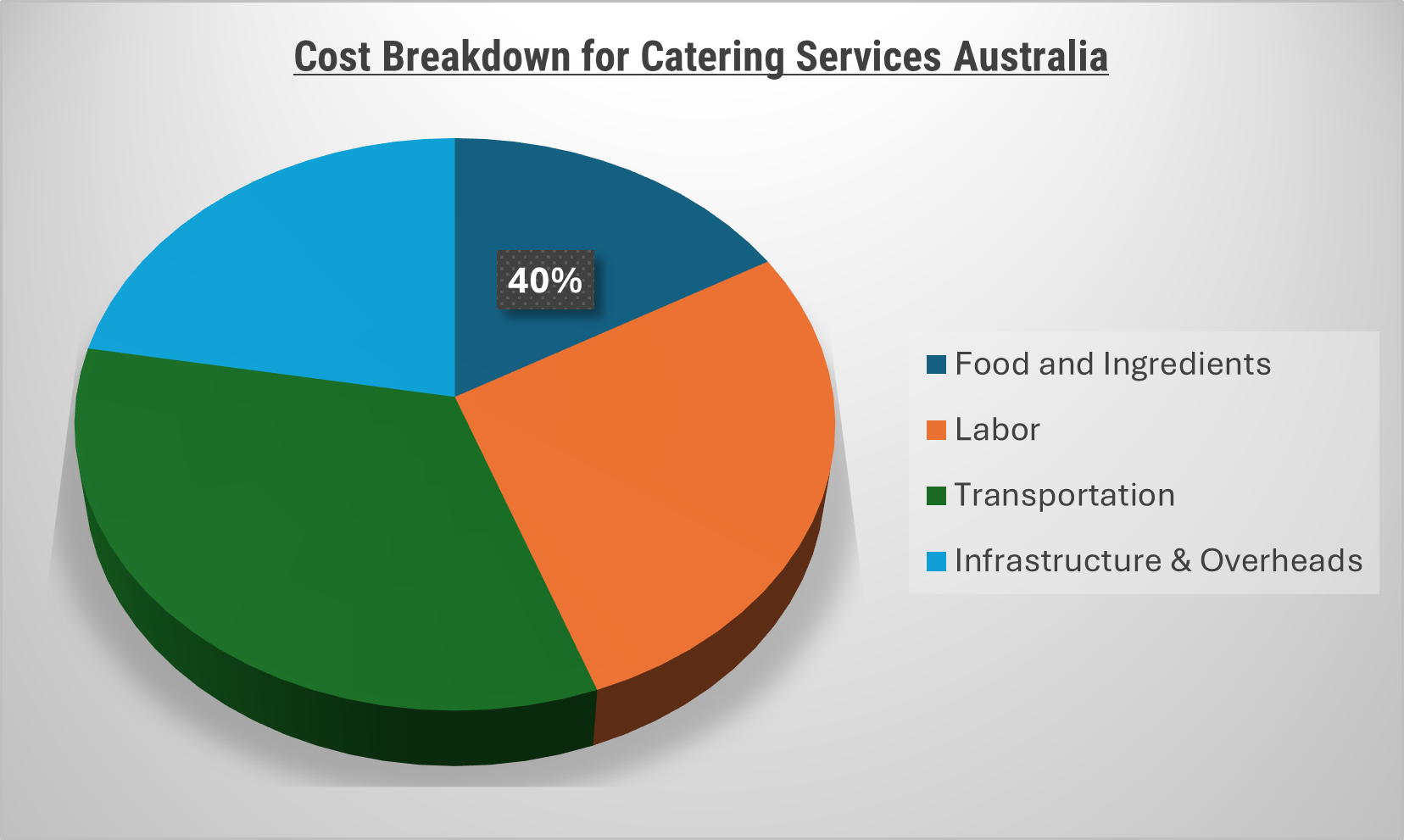
- Food and Ingredients (40%)
- Description: Essential components for catering, including fresh produce, proteins, and beverages, must meet high standards for quality and safety.
- Trends: Increasing preference for organic, sustainable, and locally sourced ingredients is shaping procurement practices. Suppliers are adopting innovative methods to enhance efficiency and reduce waste.
- Labor (XX%)
- Transportation (XX%)
- Infrastructure & Overheads (XX%)
Cost-Saving Opportunities: Negotiation Lever and Purchasing Strategies
In the catering industry, refining procurement strategies and optimizing operational processes can result in significant cost savings and improved efficiency. Building long-term relationships with food and ingredient suppliers, particularly for fresh produce, proteins, and specialty items, allows for bulk purchase discounts, leading to reduced unit costs. Strategic partnerships with catering equipment manufacturers can also help secure better payment terms and achieve economies of scale.
Investing in advanced kitchen technologies, such as automated cooking equipment and inventory management systems, reduces labor costs, enhances efficiency, and minimizes food waste. Additionally, adopting energy-efficient appliances and sourcing eco-friendly packaging materials can help lower operational costs while aligning with sustainability goals. Companies can also implement multi-sourcing strategies to reduce risks related to supplier disruptions and enhance their negotiating position in procurement discussions.
Supply and Demand Overview for Catering Services Australia: Dynamics and Buyer Intelligence for Effective Supplier Relationship Management (SRM)
The catering services market in Australia continues to grow, driven by advancements in culinary innovation and increasing demand from sectors such as corporate events, hospitality, and weddings. The dynamics of supply and demand are shaped by evolving customer expectations, advancements in kitchen technology, and the expansion of service offerings.
Demand Factors
- Corporate Events and Conferences: The rising number of business events and conferences fuels demand for professional catering services with customizable menu options.
- Hospitality Sector Growth: Increasing demand for high-quality catering in hotels and resorts drives the need for reliable service providers.
- Special Events and Weddings: The popularity of themed events and weddings is increasing the demand for bespoke catering services tailored to specific preferences.
- Health and Wellness Trends: Growing demand for healthy, organic, and dietary-specific catering options like vegan or gluten-free meals is influencing procurement strategies.
Supply Factors
- Culinary Innovation: Advances in cooking techniques, menu customization, and innovative presentation styles enhance supply capabilities.
- Availability of Skilled Chefs and Staff: Access to trained culinary professionals impacts the quality and consistency of catering services.
- Regional Production Networks: Expansion of local food production and distribution facilities improves supply efficiency and reduces costs.
- Supplier Competition: Intense competition among catering suppliers drives better service quality, innovative offerings, and competitive pricing for clients.
Regional Demand-Supply Outlook: Catering Services Australia
The Image shows growing demand for catering services australia in both Sydney and Melbourne, with potential price increases and increased Competition.
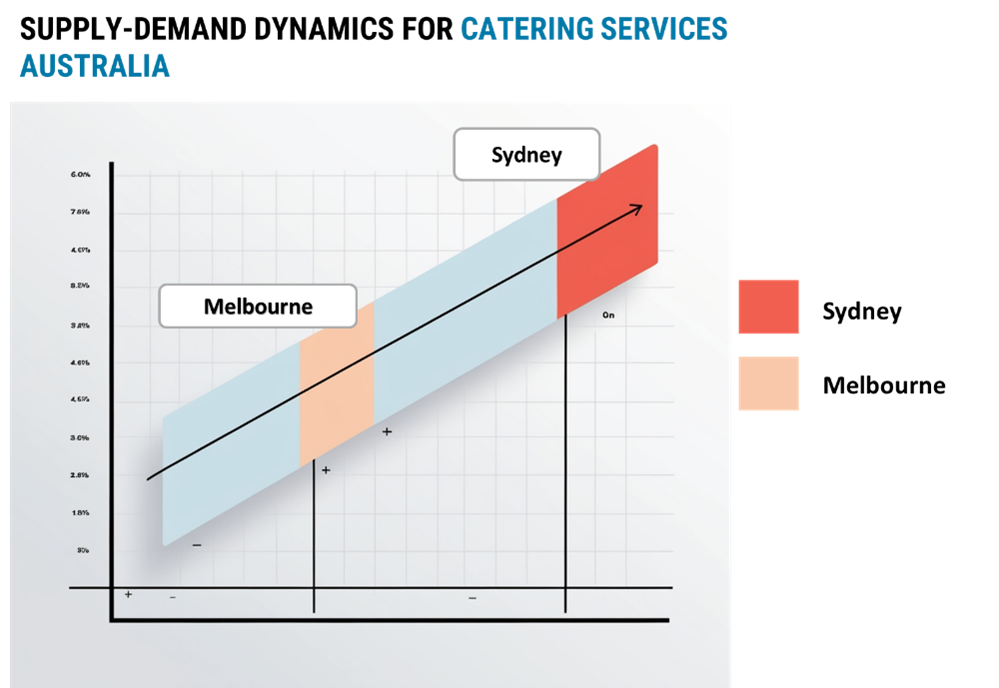
Australia: Leadership in Catering Services
Australia holds a prominent position in the catering services market in Sydney, Melbourne, and Brisbane driven by several key factors:
- Growth in Corporate and Event Catering: The increasing demand for professional catering services for corporate events, conferences, and special occasions has led Australian catering companies to innovate and expand their offerings to meet client expectations.
- Strong Food Production Capabilities: The region benefits from a robust agricultural and food production industry, providing fresh, high-quality ingredients that caterers can utilize to deliver premium services across various sectors.
- Regulatory Standards and Food Safety Compliance: Australia is known for its stringent food safety and hygiene standards, ensuring that catering services maintain high levels of quality and reliability across the industry.
- Culinary Innovation and Customization: Australian catering companies are leaders in embracing new culinary trends, such as plant-based menus and eco-friendly packaging, to address evolving consumer preferences while aligning with sustainability goals.
Australia Remains a key hub catering services price drivers Innovation and Growth.
Supplier Landscape: Supplier Negotiations and Strategies
Landscape: Supplier Negotiations and Strategies
The supplier landscape in Australia’s catering services industry is diverse, with a wide range of providers offering different solutions to meet the needs of various sectors. These suppliers play a key role in influencing pricing, service quality, and the availability of premium ingredients and catering equipment. The market is highly competitive, with both well-established players and smaller, specialized businesses focusing on niche markets such as organic catering, dietary-specific menus, and corporate event catering.
Currently, the supplier landscape is experiencing significant innovation and collaboration, as major players continue to dominate the market, while smaller firms expand by focusing on emerging trends like sustainable catering, plant-based menus, and unique dining experiences.
Key suppliers in the catering services market include:
- Spotless Group
- Sodexo Australia
- Cater Care
- Downer EDI Catering
- Hillary’s Catering
- The Fresh Collective
- Epicure
- Vino Catering
- Aus Cater
- The Catering Co.
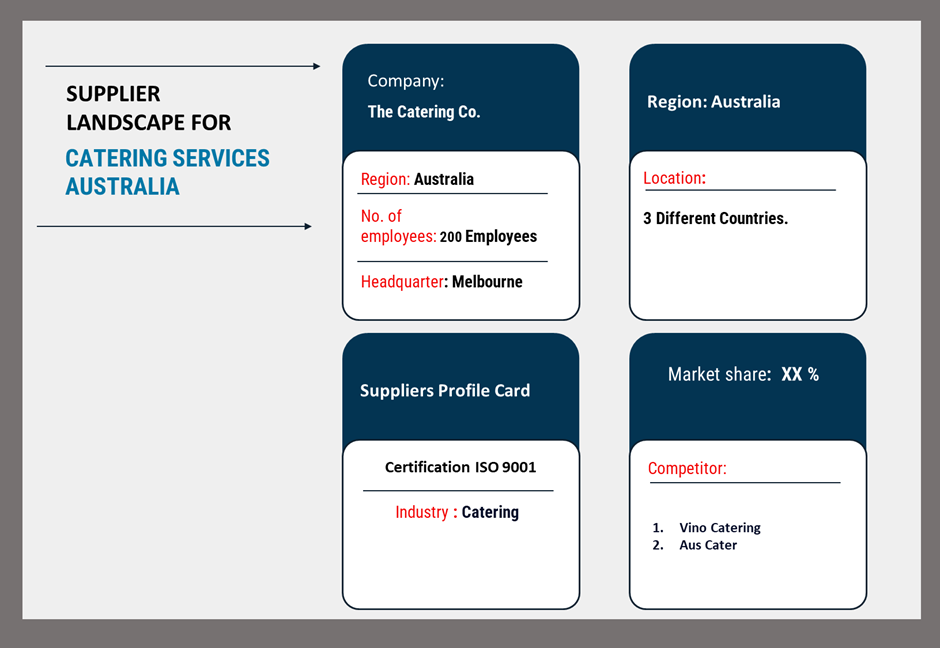
Key Developments Procurement Category Significant Development:
|
Significant Development |
Description |
|
Market Growth |
The Australian catering services market is expanding due to increased demand from corporate events, weddings, and large-scale festivals. |
|
Sustainable Practices |
Growing emphasis on using locally sourced, organic ingredients and eco-friendly packaging supports sustainability goals in the catering industry. |
|
Product Diversification |
Catering services are diversifying to include specialized offerings such as plant-based menus, gluten-free options, and international cuisine. |
|
Technological Innovations |
Adoption of technology such as online ordering systems, event management software, and automated kitchen equipment is enhancing service efficiency. |
|
E-commerce Expansion |
The rise of online platforms for event planning and catering services is making it easier for clients to access a range of catering options. |
|
Focus on Customization |
Increasing demand for tailored catering services, including bespoke menus, themed events, and dietary-specific options. |
|
Regional Catering Hubs |
Development of regional catering hubs in cities like Sydney, Melbourne, and Brisbane strengthens the supply chain and provides cost-effective solutions. |
|
Catering Services Australia Attribute/Metric |
Details |
|
Market Sizing |
The global catering services in australia market is projected to reach USD 101.68 billion by 2032, growing at a CAGR of approximately 10.41% from 2024 to 2032. |
|
Catering Technology Adoption Rate |
Around 35% of catering services are adopting digital tools such as event management software, online ordering systems, and automated kitchen technology to improve service. |
|
Top Catering Strategies for 2024 |
Focus on offering diverse menu options, enhancing food quality, ensuring compliance with dietary trends (e.g., vegan, gluten-free), and improving sustainability practices. |
|
Catering Process Automation |
Approximately 25% of catering companies have automated food preparation and delivery processes to increase efficiency and maintain high-quality standards. |
|
Catering Process Challenges |
Key challenges include managing customized menus, ensuring food safety and quality control, and meeting the growing demand for sustainable practices in food sourcing. |
|
Key Suppliers |
Leading suppliers in the Australian catering industry include top food distributors, equipment suppliers, and event planners who offer a wide range of services. |
|
Key Regions Covered |
Major demand areas include Sydney, Melbourne, Brisbane, and Perth, driven by large events, weddings, and corporate catering. |
|
Market Drivers and Trends |
Growth driven by increasing demand for corporate and event catering, evolving dietary preferences (e.g., plant-based), and a rising focus on sustainable and organic foods. |
Frequently Asked Questions (FAQ):
Our procurement intelligence services offer a comprehensive analysis of the catering supplier landscape, identifying key service providers and providing insights into market trends. We deliver spend analysis, supplier performance evaluations, and sourcing strategies to help you secure high-quality and cost-effective catering services.
We assist in assessing the TCO for catering services by factoring in costs such as food and ingredient expenses, labor, transportation, equipment, and event-related overheads. Our detailed cost analysis helps you understand the full financial impact, enabling better procurement decisions.
We offer risk management solutions that highlight potential risks such as supply chain disruptions, changes in food prices, vendor reliability, and event-specific challenges. These strategies help mitigate risks and ensure a stable supply of high-quality catering services.
Our Supplier Relationship Management (SRM) services focus on fostering strong, collaborative partnerships with catering service providers. We emphasize contract negotiations, performance monitoring, and quality assurance to ensure consistent, high-quality service at competitive prices.
We provide a set of procurement best practices for catering services, including supplier categorization, cost analysis, menu customization, and performance tracking. Our strategies help you make strategic, cost-effective sourcing decisions while maintaining service excellence.
Digital transformation enhances catering procurement through automation, real-time event tracking, and data-driven insights. By using procurement platforms and analytics, you can streamline event planning, track supplier performance, and improve cost efficiency
Our supplier performance management solutions allow you to monitor key performance indicators (KPIs) such as food quality, timely delivery, and customer satisfaction. This ensures that your catering suppliers meet agreed standards and helps improve future procurement decisions.
We help optimize negotiations by offering market insights, benchmarking supplier pricing, and leveraging bulk-order pricing or long-term agreements. Our data-driven approach ensures you secure better pricing, favourable payment terms, and added value services.
We provide market analysis tools that offer insights into industry trends, pricing fluctuations, supplier performance, and market forecasts. These tools help you make informed procurement decisions and stay ahead of evolving catering demands.
Our solutions help you navigate regulatory and industry compliance requirements, ensuring that your catering suppliers meet safety, quality, and health standards. We assist in assessing their certifications and verifying adherence to relevant regulations.
We offer strategies to manage supply chain disruptions, such as identifying alternative suppliers, diversifying food sources, and establishing contingency plans. These actions ensure your catering supply remains uninterrupted during unforeseen challenges.
Our performance tracking tools allow you to assess catering service providers over time by monitoring factors like food quality, delivery efficiency, and customer feedback. This data helps inform future procurement decisions and optimize supplier selection.
We help identify suppliers who implement sustainable practices, such as sourcing local, organic ingredients, reducing food waste, and adopting eco-friendly packaging. This ensures that your catering procurement aligns with environmental and ethical standards.
Our pricing analysis services compare costs from various catering service providers, identify pricing trends, and leverage negotiation strategies to help you secure the best value while maintaining quality service and customer satisfaction.








